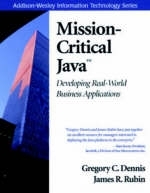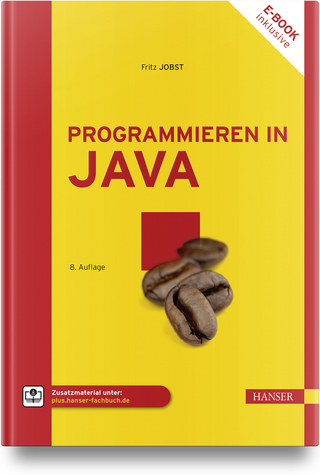
Mission-Critical Java™ Project Management
Addison Wesley (Verlag)
978-0-201-32573-7 (ISBN)
- Titel ist leider vergriffen;
keine Neuauflage - Artikel merken
The advent of the Java programming language has made the corporate computing world take notice. Java offers businesses many benefits, including the secure deployment of distributed business applications. Yet for all of its strengths, Java is still largely a mystery to professionals charged with mapping corporate computing strategy. Mission-Critical Java Project Management provides information technology professionals with the foundation they need to decide what role Java should play in their corporate IT strategy. Rather than hyping the use of Java for every application, this book documents the advantages and challenges of building Java-based business systems. The authors--experts in deploying large-scale Java business systems--provide invaluable information for those confronting the challenges and opportunities that Java presents to the corporate computing architecture. Case studies throughout the book offer real-world examples and lessons learned from the authors' personal experience using Java in business applications. The approach is candid and unbiased, and this objective view helps you learn when using Java is the best solution and when it is not.In short Mission-Critical Java Project Management will show you how Java should fit in your organization's current and future enterprise computing plans.
Highlights include: *A discussion of the risks and rewards of an enterprise-wide Java implementation using multiple case studies *An explanation of building Java-based systems from experienced consultants who have developed a complex, real-world Java business application with over one million lines of code *A case study focusing on the development of a large-scale Java business application for via World Network, an Andersen Consulting Enterprise that delivers e-commerce technologies to the travel industry 020132573XB04062001
Gregory C. Dennis is an associate partner with Andersen Consulting. He has significant experience in the formation and general management of Andersen Consulting Enterprises--including via World Network, ServiceNet, and PRA Solutions. His efforts center on the development and operation of complex business systems for client/server and Internet technologies. James R. Rubin is currently the director of technology for ServiceNet. Previously he was a technology manager for Andersen Consulting (via World Network and PRA Solutions), where he deployed information systems. 020132573XAB04062001
Preface.
1. Building Business Systems.
The Increasing Pace of Competition.
Java Technology's Rapid Rise.
Why a Book?
General Overview.
Case Study Chapters.
Via World Network (Chapter 2).
Customer Sales Support (Chapter 3).
Customer Service Support (Chapter 4).
Human Resource Service Delivery (Chapter 5).
Subject Chapter Overview.
An Enabling Technology (Chapter 6).
Is Java a Fad? (Chapter 7).
Converting Existing Business Systems (Chapter 8).
Managing a New Technology (Chapter 9).
Is Java Right for Everyone? (Chapter 10).
Bridging Procedural and Object-Oriented Styles (Chapter 11).
Building Execution Architectures (Chapter 12).
Moving beyond Applets (Chapter 13).
Overcoming Performance Challenges (Chapter 14).
Making Applications Secure (Chapter 15).
Building Highly Available Systems (Chapter 16).
Motivating Application Developers (Chapter 17).
Learning the Technology (Chapter 18).
Improving Developer Productivity (Chapter 19).
New Development Tools and Processes (Chapter 20).
Summary.
2. Case Study: Via World Network.
Introduction.
Reinventing Travel Product Distribution.
Risk Management.
Desktop viability.
Market Acceptance.
Business Case.
Software Conversion.
Developer Training.
Building the Application.
Technology Solution.
Pitfalls and Drawbacks of Using Java.
Hindsight Is 20/20.
Complexity of C-to-Java Interface.
Development Platform.
Java's On-line Functionality.
Technology Development Life Cycle.
Summary.
3. Case Study: Customer Sales Support.
Introduction.
Supporting Customer Sales.
Customer Sales Support Business Systems.
A Client/Server Sales Support System.
Converting to the Java Language.
Technology Solution.
Summary.
4. Case Study: Customer Service Support.
Introduction.
Supporting Customer Service Call Centers.
Existing Business System.
Java-Based Solution.
Technology Solution.
Summary.
5. Case Study: Human Resource Service Delivery.
Introduction.
Delivering Human Resource Services.
Solution Prototype.
Technology Solution.
Summary.
6. An Enabling Technology.
New Opportunities.
Multiple Deployment Options.
Network Computers.
Best Price/Performance.
Integrating Internet Technologies.
Summary.
7. Is Java a Fad?
The DeLorean Effect.
The Legacy of Fad Technologies.
Java's Popularity Encourages New Resources.
Developer Acceptance of Java.
Third-Party Product Support for Java Computing.
The Pace of Acceptance.
Summary.
8. Converting Existing Business Systems.
Upgrades to Business Systems.
How “Clean” Is the Legacy System?
Easing the Pain of Conversion.
A Structured Conversion Approach.
Automating Simple, Repetitive Syntax Changes.
Interfaces to Third-Party Products.
Preserving Complex Logic.
Reorganizing Source Files into Packages.
Leveraging Existing Development Tools and Processes.
Converting C/C++ Constants into Variables within Java Classes.
Creating a Java Class for Each Source File.
Converting C Function Prototypes to Method Prototypes.
Focusing on Conversion, Not Object-Oriented Design.
Incorporating Java's String Class.
Incorporating Java's Date Class.
Converting Structures into Classes.
Converting the Execution Architecture to the Java Language.
Executing the Java Compiler.
Converting Business Systems to Java.
Via World Network Conversion.
Customer Sales Support Conversion.
Summary.
9. Managing a New Technology.
Leveraging a New Technology.
Java's Rise in Popularity.
Challenges in Using a New Technology.
Don't Depend on Vendors to Come to the Rescue.
Development Tools Are Emerging.
Integration with Existing Products.
There Are Still Bugs in Java.
Java Skills Are Scarce.
There Are Few Large Java Business Systems.
Java Risk Management.
Weigh Advantages against Risks.
Identify Custom Technology Integration Requirements.
Prototype the Technology Implementation.
Begin Development with a Pilot Set of Developers.
A Pioneer's Challenges.
Summary.
10. Is Java Right for Everyone?
Is Java Right for the Business?
Technology Challenges.
Before Using Java, Ask These Questions.
Technology Leadership.
Have Developers Been Experimenting?
A “Filling-the-Gaps” Culture.
Third-Party Product Support.
A Fast-Paced, Rapidly Changing Environment.
Does the Company Have a “Green Field” Project?
Does the Business Have the Right Skills?
Acquiring the Right Skills.
Summary.
11. Bridging Procedural and Object-Oriented Styles.
Application Development Styles.
Objects Are Not for Everyone.
Fine-Grained Object-Oriented Design Is Difficult to Attain.
Reuse Is Difficult.
The Pervasiveness of Procedural Systems.
Combining Object-Oriented and Procedural Styles.
Java Bridges the Two Styles.
Example Java-Based Object/Procedural Systems.
Summary.
12. Building Execution Architectures.
Execution Architectures.
The Business Case.
The Downside of Execution Architectures.
Advantages of Java.
No Memory Management.
Standard, Comprehensive Approach to Error Handling.
Platform Independence.
Network Communication Building Blocks.
Security.
Base Classes.
Example Solutions on the Web.
Simpler Object-Oriented Approach.
Third-Party Products Leveraging Java.
Java's Multithreading Capabilities.
Java's Shortcomings.
A Java Execution Architecture.
On-line Travel Booking.
Customer Sales Support System.
Call Center Customer Support.
Human Resource Service Delivery.
Summary.
13. Moving Beyond Applets.
Complex Business Systems.
Implementation Challenges.
Server-Side Business Services.
Deploying Client/Server Applications.
Impact of Emerging Standards.
Java Technology's Role.
Providing Server-Side Business Services.
Deploying Client/Server Applications.
Summary of Key Technology Components.
What about ActiveX and CORBA?
Competing Standards.
Real-World Systems.
An ActiveX-CORBA Survival Strategy.
Case Studies.
Summary.
14. Overcoming Performance Challenges.
The Performance of Business Systems.
Challenges of a New Technology.
Addressing Java Technology Performance.
Via World Network-Java Performance.
Passage of Time.
Improvements in Price/Performance.
Portability of Java.
High-Quality Business Logic.
Predictable and Consistent Behavior.
Scalable Business Logic Design.
Via World Network Business Logic.
In-Memory Table Loads.
Message Logging.
Global Object Declaration.
Redundant Object Instantiation.
Object Creation and Control Structures.
Via World Network Execution Architecture.
In-Memory Table Storage Size.
Java String and Date Objects.
Memory Heap Size of the Java Interpreter.
Database Access.
Message Logging.
Via World Network Results.
Summary.
15. Making Applications Secure.
Internet Security for Businesses.
Security Concerns of Java.
Reasons Not to Worry.
Breaking Java Has Become a “Sport.”
Before Java, This Was Not a Problem.
Java Applications Can Be Installed Locally.
Developing Secure Applications.
“Internet-Friendly” Communications.
Reliable and Secure Transmissions.
Summary.
16. Building Highly Available Systems.
Business System Requirements.
Implementation Challenges.
Single-Vendor Strategies.
A Multivendor Strategy.
The Role of Java Technology.
The Travel Industry's High Availability Requirements.
Via World Network's Approach.
Summary.
17. Motivating Application Developers.
Developers at the Java One Conference.
A Variety of Reasons.
Java Is New and Different.
Java Technology Is Cutting-Edge.
The Industry Has Overhyped Java.
Java Programming Is Easy to Learn.
Animated Web Pages.
Java Increases Prototyping Speed.
Sharing of Java Code.
Excitement over the Internet.
Developers Are Motivated to Work with Java Technology.
Developers Work Harder.
Recruiting Is Easier.
Developers Have a Positive Attitude.
Developers Establish Professional Contacts.
Experiences with the Interest in Java.
Summary.
18. Learning the Technology.
The Cost of Training.
Java Is Easier to Learn.
Simpler Syntax.
Similarity to C and C++.
Wide Base of Documentation.
Prebuilt Building Blocks.
Simpler Memory Management.
User-Friendly Compiler.
Platform Independence.
Simplified Systems Programming.
Simplified Object-Oriented Programming.
Impact of Java on New and Experienced Developers.
Learning Java Still Takes Time.
Via World Network Training.
Training Tips.
Summary.
19. Improving Developer Productivity.
Programming Is a Complex, Time-Consuming Task.
Java Programming Increases Developer Productivity.
Memory Management.
Compiler.
Base Classes.
Systems Programming.
Platform Independence.
Object-Oriented Programming.
Error Handling.
Aspects That Hinder Productivity.
Development Tool Immaturity.
Pool of Experienced Programmers.
Few Examples of Business Systems.
Java Reduces Application Development Time.
Release One Development.
Release One System Testing.
Release One Summary.
Release Two Summary.
Production Operations.
Overall Summary.
Summary.
20. New Development Tools and Processes.
Development Tools and Processes.
Java Programming's Impact on Development.
Application Debuggers.
GUI Painters.
Program Editor.
Source Code Control Facility.
Compilation Utilities.
Programming Standards.
Development Platforms.
Switching to Java.
Development and Production Platform.
Development Process and Methodology.
Source Code Control Facility.
Compilation Utility.
Program Editors.
Debugger.
GUI Painter.
Summary.
Glossary.
Index. 020132573XT04062001
| Erscheint lt. Verlag | 2.10.1998 |
|---|---|
| Verlagsort | Boston |
| Sprache | englisch |
| Maße | 180 x 235 mm |
| Gewicht | 465 g |
| Themenwelt | Informatik ► Programmiersprachen / -werkzeuge ► Java |
| Mathematik / Informatik ► Informatik ► Web / Internet | |
| ISBN-10 | 0-201-32573-X / 020132573X |
| ISBN-13 | 978-0-201-32573-7 / 9780201325737 |
| Zustand | Neuware |
| Informationen gemäß Produktsicherheitsverordnung (GPSR) | |
| Haben Sie eine Frage zum Produkt? |
aus dem Bereich


